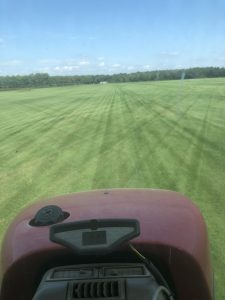
Before we begin, it’s probably worth it to understand more about the life cycle of crabgrass.
If you live in a rental property-based neighborhood, and are annoyed to see crabgrass everywhere, take a minute to regain some perspective. It could be as simple as the groundskeepers not knowing how to recognize this pest. At the same time, they might not know how to deal with it, either.
The Life Cycle
Before we begin, it’s probably worth it to understand more about the life cycle of crabgrass. After all, knowing your enemy is half the battle. For starters, crabgrass is known as a warm-season annual. This means that it starts to flourish in the spring and thrives during the summer. Fall is here, and that normally brings colder temperatures with it. But with the continuing heat dome, it still feels like summer hasn’t ended yet, and as a result, it can encourage further crabgrass plant growth even though the plants should be out of season by now. Each plant can leave behind up to 150,000 seeds that can survive as long as they don’t germinate. That’s how every spring you will see new colonies of crabgrass even if you already dealt with last year’s invasion. Mowers aren’t enough to stop these interlopers from taking over your lawn!
Stopping Crabgrass from Growing
The first step is to stop the crabgrass from growing at all if you can. In some cases, you will want to refer to the experience of lawn care professionals, especially if you have a strong allergy to grass and don’t want to take chances. In that case, pre-emergent herbicides are probably your best bet. These treatments stop the seeds from germinating and also slows down the ability of the roots to take hold. Crabgrass is a weed, and many other broadleaf weeds can also be thwarted by using these solutions. Just be careful not to overdo it, though; overseeding healthy lawn grass seeds can be a bad idea here because the herbicides can also affect them in negative ways.
Killing the Existing Crabgrass
Now let’s focus our attention on how to eliminate any crabgrass that is already there. This step is where the so-called “post-emergents” take center stage. These are formulated to target any plants instead of the seeds that they sprout from; this also stops the crabgrass from producing more seeds and prevent future generations from growing. Be sure to choose selective herbicides to protect your grass and your lawn in general!
Have More Questions? Stay in Touch!
Order early, and order often to ensure the best service possible. Contact us through our online page. Find us at 27616 Little Lane, Salisbury, Maryland 21801. Our phone number is 410-726-6103, and our fax number is 410-742-6550. Speak to Jason Anderson for Turf Grass Sales. Reach him by email at jason@quanticocreeksod.com. Finally, follow us on social media on Facebook, LinkedIn, and our blog!
